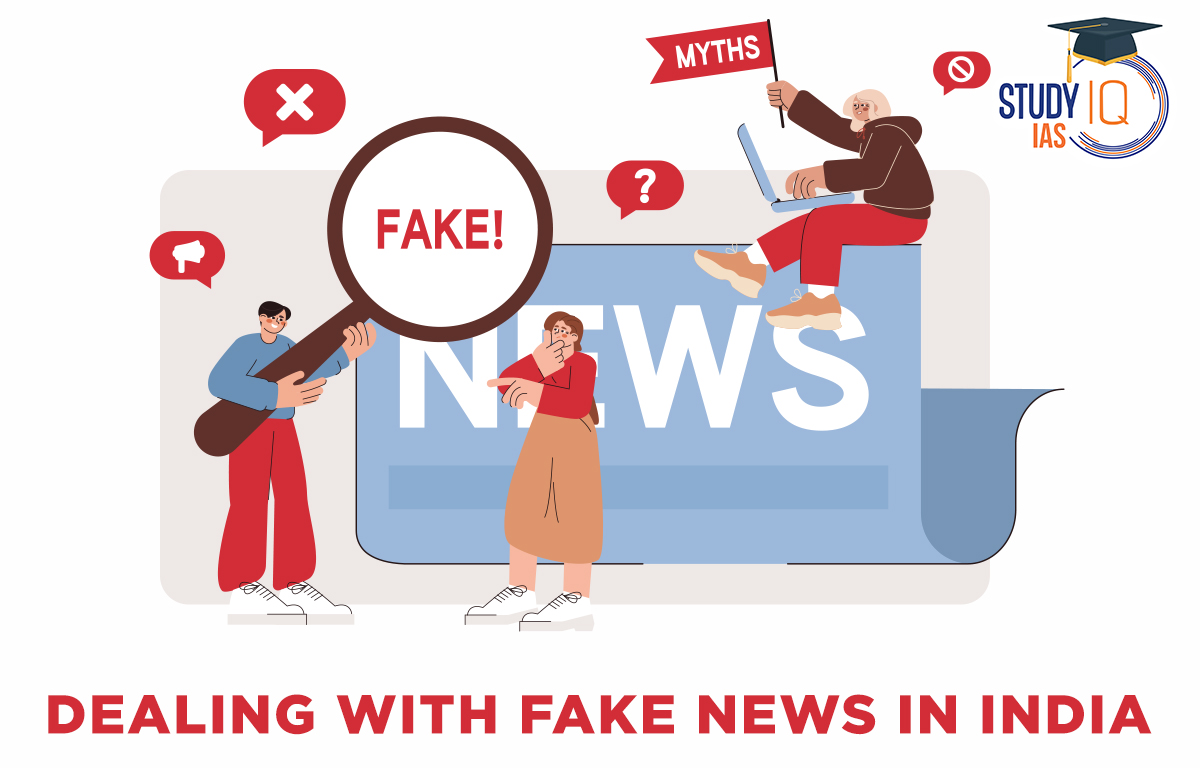Table of Contents
Context: Recently, the Ministry of Electronics and IT notified amendments to the Information Technology Rules, 2021, which allows the Ministry to appoint the fact-check body.
What is Fake News?
- Fake News: Fake news has three different notions: misinformation, disinformation, and mal -information.
- Misinformations are false information, but when a person conveys, it is believed to be true and is shared.
- Disinformation is a type of information that is false and deliberately created to harm a person, social group, organisation or country.
- Information based on reality but imposes harm on a person, organization, or country is termed as mal-information.
- After putting all of them together, we call it fake news.
- Types of Fake News: Satire or parody (no intention to cause harm), misleading content, imposter content, fabricated/false/manipulated content, etc.
- New Amendment: The Central Government has notified Amendments to the Information Technology (Intermediary Guidelines and Digital Media Ethics code) rules, 2021 for an Open, Safe & Trusted and Accountable Internet.
The Problem of Fake News in India
- Lack of Authenticity: Fake news confuses people as its authenticity is questioned when shared on social media. It is posing a major challenge for the news media.
- Perpetuates Violence: Fabricated and manipulated content leads to the possibility of potential violence and impacts the society.
- Deepens Communal Polarisation: Content that denigrates leaders/groups of the opposite ideology based on falsehoods, deepens communal polarisation or incites hatred leading to communal violence in India.
- Lack of Regulatory Mechanisms: Big social media platforms like WhatsApp are still grappling with compromising mechanisms for privacy like encryption and the urgent need to remove fake news spread through its application.
- No Accountability: Online platforms have scope for wrongdoing due to the lack of binding rules, and the ability to keep owners and editors private like in the case of fake news sites.
- In the absence of such crucial information, there is no understanding of the liability and the credibility of the information that is being hosted on their respective sites.
Important Amendments related to Fake News in the Information Technology Rules, 2021
- Appointment of Fact-check Unit: The Central Government will allow a fact-check body appointed by it to label online content related to the Union Government as “fake” or “misleading”.
- Removal of Fake Content: If any piece of information is marked as fake by the upcoming fact check unit, online intermediaries will be required to take it down. Internet service providers will have to block URLs of such content.
- If online intermediaries fail to remove such content, they would risk losing their safe harbour, which protects them from litigation against third-party content.
- Efforts to Reduce Fake Content: Online intermediaries including social media platforms and internet service providers should make “reasonable efforts” to not host content related to the Central Government that is “identified as fake or misleading” by the fact check unit.
Shreya Singhal vs Union of India Case
- The amendment to the IT Act, 2000, gave the Central Government power to arrest and imprison an individual for allegedly “offensive and menacing” online posts.
- Section 66A of the Act prescribed the punishment for sending messages through a computer or any other communication device like a mobile phone or a tablet, and a conviction could fetch a maximum of three years in jail.
- In Shreya Singhal v. Union of India case (2015), the Supreme Court of India declared Section 66A as unconstitutional for “being violative of Article 19(1)(a) and not saved under Article 19(2).
- Article 19 (1) (a) gives peoples the right to speech and expression whereas 19(2) gives the state the power to impose “reasonable restrictions” on the exercise of this right.
Criticism of the New Amendment
- Censorship of Press: The Editors Guilds of India has stated that these amendments will have deeply adverse implications for press freedom in the country.
- The determination of fake news in the sole hands of the government will result in censorship of the press.
- Against Natural Justice: New rules are against principles of natural justice and will have a chilling effect on the media.
- More Power to Fact Checking Unit: New rules may make it easier to muzzle the free press, and will give sweeping powers to the agency authorized by the Central Government for fact checking, to force online intermediaries to take down content that the government may find problematic.
- Curb Legitimate Criticism: New amendments stifle legitimate criticism of the government and will have an adverse impact on the ability of the press to hold governments to account, which is a vital role it plays in a democracy.
- Lack of Governing mechanisms: New rules do not mention any governing mechanism for a fact-checking unit, the judicial oversight, the right to appeal, or adherence to the guidelines laid down by the Supreme Court of India.
Way Forward
- The lack of uniform guidelines, regulation and policy regarding fabricated content needs to be addressed urgently in India.
- As the circulation of fake news is strongly impacting the society and perpetuating hatred and violence, it is essential that stringent guidelines are laid down to curb the same.
- At the same time, it is imperative to ensure that the government-backed fact check body will work in a credible way, in a bid to address the concerns and does not strangle real criticism.


 List of Governor of States in India, Con...
List of Governor of States in India, Con...
 Daily Quiz 15 July 2025
Daily Quiz 15 July 2025
 Maratha Military Landscapes of India Add...
Maratha Military Landscapes of India Add...





















